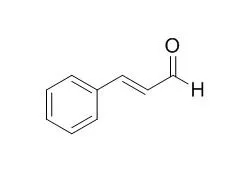| Description: |
Cinnamic aldehyde, a COX-2 inhibitor, exhibits cardioprotective, antidepressant-like, anti-leukemia, anti-oxidative and anti-inflammatory properties. Its supplementation can improve glucose and lipid homeostasis in diabetic animals. |
| Targets: |
COX | PGE | TNF-α | IL Receptor | NO | ATPase | SOD |
| In vitro: |
| Zhongguo Shi Yan Xue Ye Xue Za Zhi. 2011 Jun;19(3):617-20. | | Mechanism of cinnamic aldehyde-inducing apoptosis of chronic myeloid leukemic cells in vitro.[Pubmed: 21729535] | The aim of this study was to investigate the apoptosis-inducing effect of Cinnamic aldehyde (CA) on chronic myeloid leukemic (CML) cells and its mechanism.
METHODS AND RESULTS:
K562 cells and primary bone marrow mononuclear cells (MNC) from patients with CML were treated by various concentrations of CA. Flow cytometry was employed to measure the apoptosis of K562 cells and primary CML bone marrow MNC. Western blot was used to determine the expression of C-MYC and the phosphorylation of CrkL in K562 cells, and real-time polymerase chain reaction (real-time PCR) was used to quantify the expression of BCR-ABL mRNA in K562 cells. The results indicated that CA induced the apoptosis of K562 cells in a time- and dose-dependent manner. CA induced apoptosis of CML MNC dose-dependently. CA inhibited the expression of BCR-ABL mRNA and C-MYC, reduced CrkL phosphorylation levels in K562 cells.
CONCLUSIONS:
It is concluded that CA induces apoptosis of CML cells in vitro. Down-regulation of the expression and function of BCR-ABL may be one of its most important anti-leukemia mechanisms. | | J Agric Food Chem. 2013 Feb 27;61(8):1794-803. | | Potent nematicidal activity of phthalaldehyde, salicylaldehyde, and cinnamic aldehyde against Meloidogyne incognita.[Pubmed: 23379671] |
METHODS AND RESULTS:
The nematicidal activity of selected aromatic aldehydes was tested against the root knot nematode Meloidogyne incognita. The most active aldehyde was phthalaldehyde (1) with an EC(50) value of 11 ± 6 mg/L followed by salicylaldehyde (2) and Cinnamic aldehyde (3) with EC(50) values of 11 ± 1 and 12 ± 5 mg/L, respectively. On the other hand, structurally related aldehydes such as 2-methoxybenzaldehyde (21), 3,4-dimethoxybenzaldehyde, and vanillin (23) were not active at the concentration of 1000 mg/L. By liquid chromatography-mass spectrometry the reactivity of tested aldehydes against a synthetic peptide resembling the nematode cuticle was characterized. At the test concentration of 1 mM, the main adduct formation was observed for 3,4-dihydroxybenzaldehyde (22), 2-methoxybenzaldehyde (21), and 3,4-dimethoxybenzaldehyde. Considering that 2-methoxybenzaldehyde (21) and 3,4-dimethoxybenzaldehyde were not active against M. incognita in in vitro experiments led us to hypothesize a different mechanism of action rather than an effect on the external cuticle modification of nematodes. When the toxicity of the V-ATPase inhibitor pyocyanin (10) was tested against M. incognita J2 nematodes, an EC(50) at 24 h of 72 ± 25 mg/L was found. The redox-active compounds such as phthalaldehyde (1) and salicylaldehyde (2) may share a common mode of action inhibiting nematode V-ATPase enzyme.
CONCLUSIONS:
The results of this investigation reveal that aromatic redox-active aldehydes can be considered as potent nematicides, and further investigation is needed to completely clarify their mode of action. |
|
| In vivo: |
| J Ethnopharmacol. 2015 Mar 13;162:97-103. | | Cinnamic aldehyde treatment alleviates chronic unexpected stress-induced depressive-like behaviors via targeting cyclooxygenase-2 in mid-aged rats.[Pubmed: 25556926] | COX-2 has been considered as a potent molecular target for prevention and therapy of depression. However, a recent study showed that COX-2 inhibitor does not improve depressive symptoms in persons aged 70 and over. Therefore, whether treatments targeting COX-2 have a clinical efficacy in depression, especially elderly individuals, remains unclear. Cinnamic aldehyde is a major constituent of Cinnamomum cassia, which has exhibited excellent anti-inflammatory activities as a COX-2 inhibitor. To investigate the potential antidepressant effect of Cinnamic aldehyde in mid-aged rats.
METHODS AND RESULTS:
The depressive-like behaviors were measured after the rats exposed to chronic unexpected mild stress (CUMS). Cinnamic aldehyde was administrated by oral gavage to stressed rats (22.5, 45, 90 mg/kg, respectively) for 21 days. The mRNA, protein expression and activity of cyclooxygenase-2 (COX-2), as well as prostaglandin E2 (PGE2) levels were measured in the frontal cortex and hippocampus of stressed animals. We found that CUMS procedure not only decreased the sucrose preference, but also elevated the COX-2 activity, mRNA and protein levels, and increased PGE2 concentration in rat brain regions. Treatment with high doses of Cinnamic aldehyde (45, 90 mg/kg) reversed the behavioral abnormalities, and decreased the COX-2 protein and activity (but not COX-2 mRNA expression) and PGE2 concentration in frontal cortex and hippocampus of stressed rats.
CONCLUSIONS:
Cinnamic aldehyde exerted antidepressant-like effects in stressed mid-aged rats, and its mechanism of action appears to decrease COX-2 protein and activity. The current findings suggest that targeting COX-2 system might be benefit to the depression, especially elderly individuals and Cinnamic aldehyde might be a promising medicine to treat the subjects in the depression. |
|






 Cell. 2018 Jan 11;172(1-2):249-261.e12. doi: 10.1016/j.cell.2017.12.019.IF=36.216(2019)
Cell. 2018 Jan 11;172(1-2):249-261.e12. doi: 10.1016/j.cell.2017.12.019.IF=36.216(2019) Cell Metab. 2020 Mar 3;31(3):534-548.e5. doi: 10.1016/j.cmet.2020.01.002.IF=22.415(2019)
Cell Metab. 2020 Mar 3;31(3):534-548.e5. doi: 10.1016/j.cmet.2020.01.002.IF=22.415(2019) Mol Cell. 2017 Nov 16;68(4):673-685.e6. doi: 10.1016/j.molcel.2017.10.022.IF=14.548(2019)
Mol Cell. 2017 Nov 16;68(4):673-685.e6. doi: 10.1016/j.molcel.2017.10.022.IF=14.548(2019)